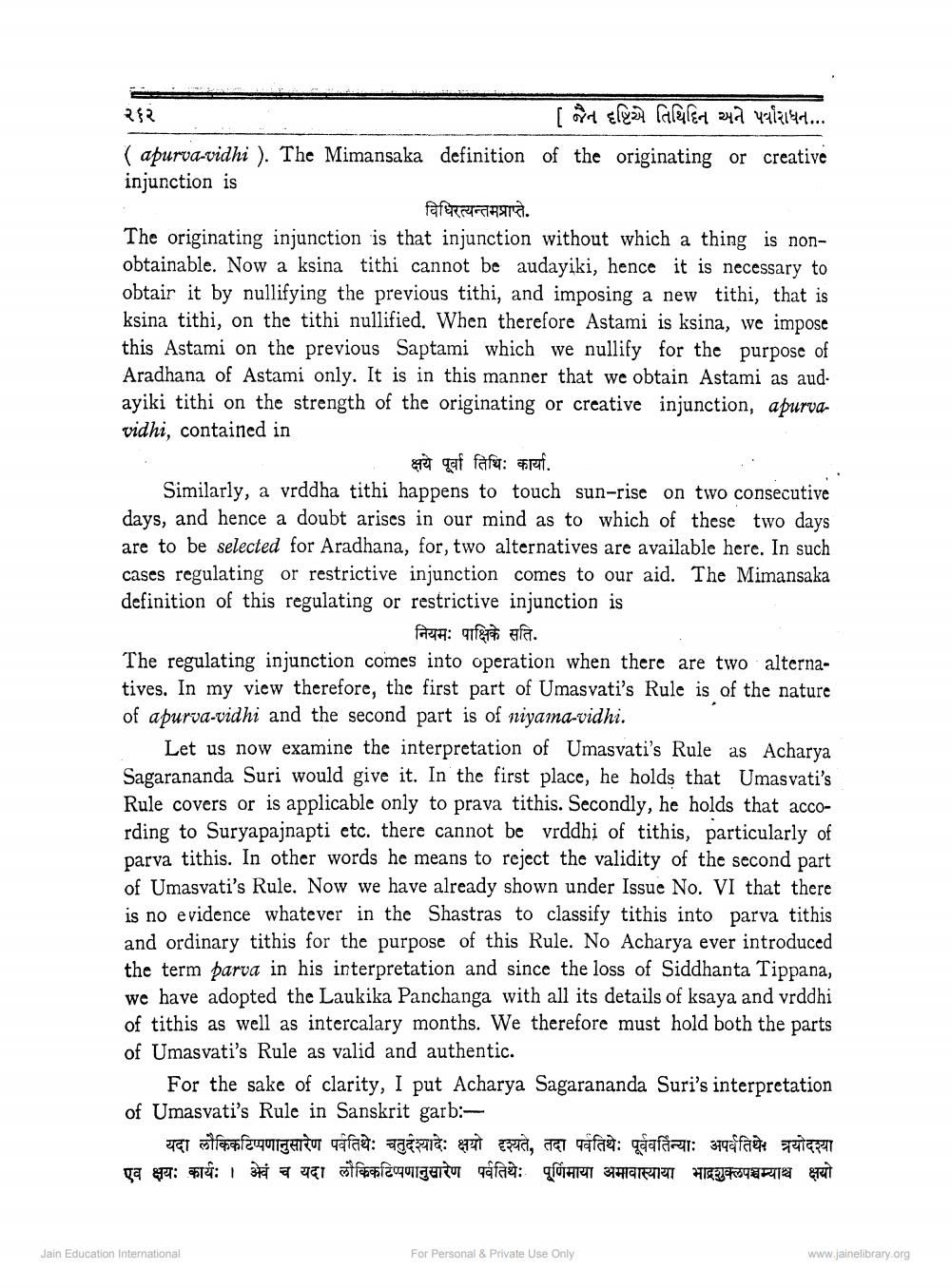________________
[ જૈન દૃષ્ટિએ તિથિદિન અને પર્વોરાધન... (apurva-vidhi). The Mimansaka definition of the originating or creative injunction is
ર૬ર
विधिरत्यन्तमप्राप्ते.
The originating injunction is that injunction without which a thing is nonobtainable. Now a ksina tithi cannot be audayiki, hence it is necessary to obtair it by nullifying the previous tithi, and imposing a new tithi, that is ksina tithi, on the tithi nullified. When therefore Astami is ksina, we impose. this Astami on the previous Saptami which we nullify for the purpose of Aradhana of Astami only. It is in this manner that we obtain Astami as audayiki tithi on the strength of the originating or creative injunction, apurvavidhi, contained in
क्षये पूर्वा तिथि: कार्या.
Similarly, a vrddha tithi happens to touch sun-rise on two consecutive days, and hence a doubt arises in our mind as to which of these two days. are to be selected for Aradhana, for, two alternatives are available here. In such cases regulating or restrictive injunction comes to our aid. The Mimansaka definition of this regulating or restrictive injunction is
नियमः पाक्षिके सति.
The regulating injunction comes into operation when there are two alternatives. In my view therefore, the first part of Umasvati's Rule is of the nature of apurva-vidhi and the second part is of niyama-vidhi.
Let us now examine the interpretation of Umasvati's Rule as Acharya Sagarananda Suri would give it. In the first place, he holds that Umas vati's Rule covers or is applicable only to prava tithis. Secondly, he holds that according to Suryapajnapti etc. there cannot be vrddhi of tithis, particularly of parva tithis. In other words he means to reject the validity of the second part of Umasvati's Rule. Now we have already shown under Issue No. VI that there is no evidence whatever in the Shastras to classify tithis into parva tithis and ordinary tithis for the purpose of this Rule. No Acharya ever introduced the term parva in his interpretation and since the loss of Siddhanta Tippana, we have adopted the Laukika Panchanga with all its details of ksaya and vrddhi of tithis as well as intercalary months. We therefore must hold both the parts of Umasvati's Rule as valid and authentic.
For the sake of clarity, I put Acharya Sagarananda Suri's interpretation of Umasvati's Rule in Sanskrit garb:
यदा लौकिक टिप्पणानुसारेण पर्वतिथेः चतुर्दश्यादेः क्षयो दृश्यते, तदा पर्वतिथेः पूर्ववर्तिन्याः अपर्वतिथेः त्रयोदश्या एव क्षयः कार्यः । अवं च यदा लौकिक टिप्पणानुसारेण पर्वतिथे: पूर्णिमाया अमावास्याया भाद्रशुक्लपञ्चम्याश्च क्षयो
Jain Education International
For Personal & Private Use Only
www.jainelibrary.org




